The Samsung 950 Pro PCIe SSD Review (256GB and 512GB)
by Billy Tallis on October 22, 2015 10:55 AM ESTSequential Write Performance
The sequential write test isn't limited to a small span of the disk, as that usually doesn't make a difference for this performance metric. As always, our averages are of the lower queue depths, but scaling to higher queue depths is also investigated. Bulk file copies and recording uncompressed video are the kind of uses that depend on sequential write performance.
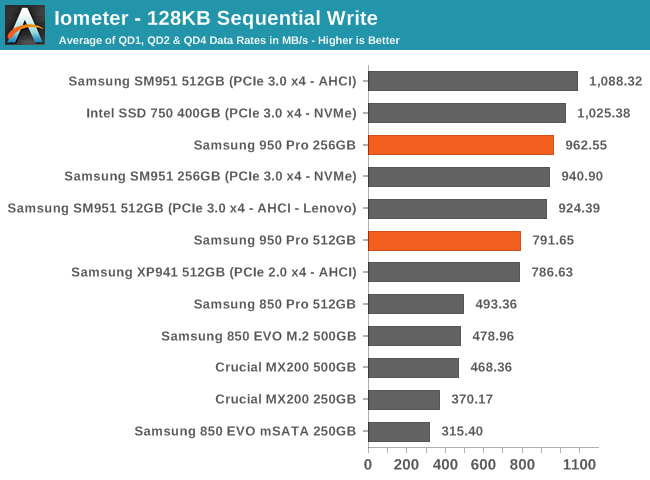
Even at low queue depths, most SSDs can spread a sequential write workload across multiple channels to achieve very high throughput. All of the PCIe drives perform well above the SATA limit but nowhere near the capacity of the PCIe links. The 512GB 950 Pro seems to again be encountering thermal throttling, and more severely than the SM951s we tested.
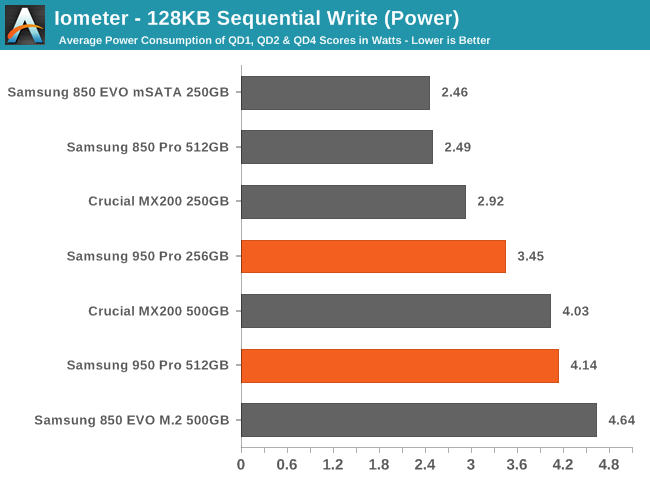
The average power consumption for writes is still on the high side by SATA standards, but is quite reasonable in light of the performance achieved.
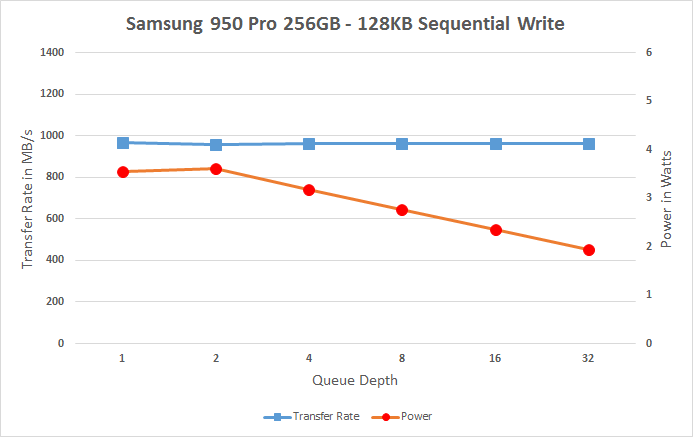 |
|||||||||
Performance across the sequential write test is mostly constant, but power isn't. The declines in power consumption in spite of increased queue depth are again most likely an artifact of whatever background processing is going on in the drive. On SATA drives, it's usually obvious from looking at the power meter when a drive has completed background processing and is truly idle and ready to run the next test, but with the lack of working power management for PCIe drives on our testbed I'm not so sure here. Overall it's probably a good sign that the drives were able to maintain high performance in spite of whatever else was going on, but given more cooling the 512GB can probably do much better.
Sequential Read Performance
Just like the random read test, sequential reads are tested across the span of a full drive and a representative sample of queue depths. Most operations involving large files (typically images and videos) fall under this test's purveiw, but streaming or playing even the highest resolution videos won't be a challenge for any of these drives. Copying files to another SSD or loading a new level in a video game would be more likely to show noticeable difference from better performance here.
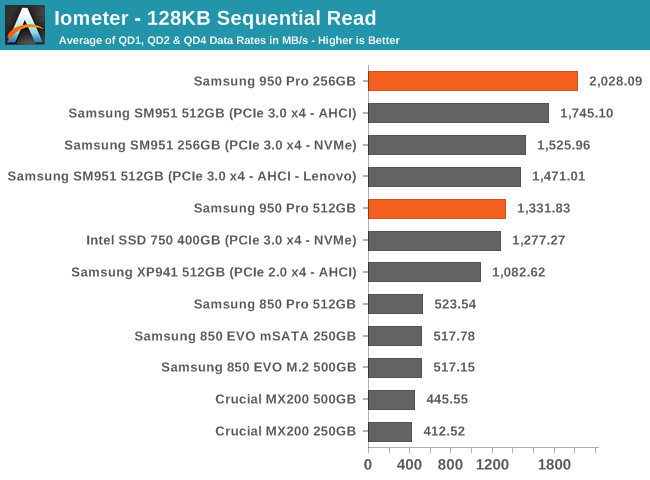
The sequential read performance is probably the best showcase of what the PCIe 3.0 x4 interface can do. The 256GB 950 Pro attains over half of the link speed, but the 512GB is again bogged down by something—relatively speaking, since it's still more than twice the speed of SATA and faster than even the Intel SSD 750. It's possible that the 950 Pro isn't faithfully implementing the secure form of the NVMe format command and some lingering fragmentation is preventing the 512GB drive from performing as specified. Read operations require less power to be supplied to the flash chip than for writes, but if the thermal throttling is all in the controller it could be showing up here as well.
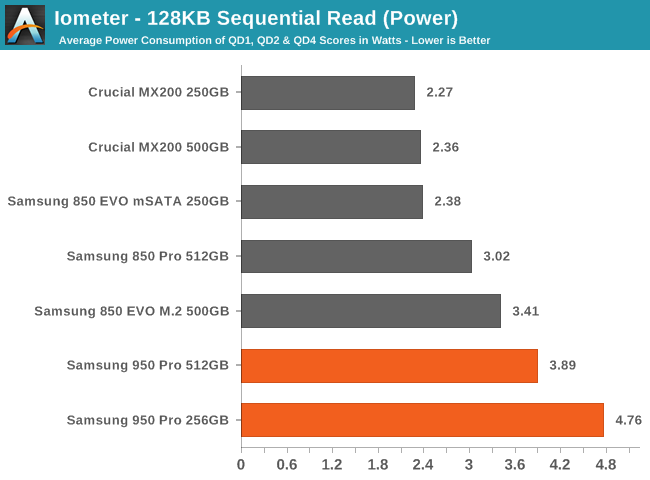
Relative to each other, the 950 Pro's power consumption is in line with the performance they're demonstrating, and proportionally much better than the SATA drives.
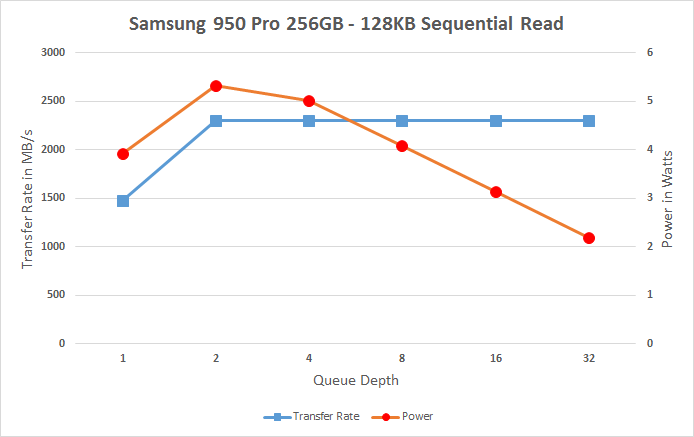 |
|||||||||
At queue depth 1, both of the 950 drives are performing similarly. When moving to higher queue depths the 256GB immediately hits 104% of its rated speed, but the 512GB doesn't improve any. (It's worth noting the differing scale for Transfer Rate in the graphs above.) The puzzling decline in power consumption at higher queue depths shows up again on the 256GB and definitely warrants deeper investigation.










142 Comments
View All Comments
user_5447 - Thursday, October 22, 2015 - link
Yeah, just buy Skylake motherboard, CPU and DDR4 RAM.And I'm not saying that it's simple, I'm saying that it's possible. You don't have to do anything special after setting it up, just keep small USB drive plugged in at the back of your PC.
user_5447 - Thursday, October 22, 2015 - link
Also, you can do it without additional USB drive, if you have at least one installed SATA device.Redstorm - Thursday, October 22, 2015 - link
Still a crap solutionEssence_of_War - Thursday, October 22, 2015 - link
I have had exactly two problems with GRUB.1) When windows destroys it because lolz.
2) When I was trying to install gentoo into a zfs root with on a luks encrypted disk.
Grub is fine and has been for a while.
SyukriLajin - Friday, October 23, 2015 - link
windows shouldn't be able to mess with it if grub is installed on an external usb drive, and then setting the usb drive as the main boot device(all bios i've seen supports this). it's called chainloading, and it's not a bad hack if you don't have all the proper hardware but still want to try it. of course, it will require some technical knowledge. and because i'm poor, and can't afford a new system, if it works, it's good enough.hero4hire - Sunday, October 25, 2015 - link
If you're poor you wouldn't buy a nvme ssd. It is interesting to talk possibilities thoughEwitte12 - Saturday, October 24, 2015 - link
It didn't take much to figure out how to insert the nvme modules into a z87 motherboard. However I was prepared to replace it with a z97 if it messed up. I was NOT even considering the 600+ to go to skylake.Redstorm - Thursday, October 22, 2015 - link
Because what you propose is not a very good solution at all.eddieobscurant - Thursday, October 22, 2015 - link
The problem with that theoretical solution (which i've tried) is that windows won't let you install on it when it lists the disk drives.If you migrate an installation from a sata drive, you get a bsod upon restart due to the different ahci/nvme drive required similar to the ahci/ide for sata drives.
So there isn't a solution
Gigaplex - Thursday, October 22, 2015 - link
You'd need to use the Windows deployment tools such as DISM to apply the WIM file, rather than run the regular install wizard.